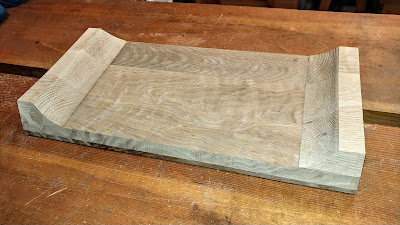The recently completed kitchen work table is a success, so we now need a pair of stools to go with it. I looked at a lot of pictures online and the style that caught my eye is called a saddle seat stool. They have a rectangular seat, usually around 9"x18" that is contoured somewhat like the side view of a saddle, so I suppose that is how it got its name. These stools usually have four legs. Think of a short stepladder. Generally there are two sets of stretchers on each side, but sometimes the legs are mortised into the seat and there is only one stretcher on each side. There are all kinds of variants, including rustic ones that look really nice.
Since the kitchen work table is white oak, the stools are going to be white oak, Carving out the seat shape in dry white oak would be extremely difficult, if not impossible, with hand tools. These days, this sort of thing is often done by power carving. It involves a nasty looking cutter on an angle grinder with chips and dust (hopefully not flesh) flying everywhere. It's not for me, so I have to do something else.
I still have a lot of the pickup load of scrap 5/4 white oak that I bought last year, so I decided to experiment with it. After gluing up a piece 9" wide, I used a french curve to sketch out the profile I wanted and cut it out on the bandsaw. Then I used a round spokeshave, a rasp and a file to refine it:
I then glued these to a 9"x18" base. Finally I used the bandsaw to angle the edges slightly inward as a start for using hand tools for shaping. The resulting seat blank looked better to my eye than I expected:
The main thing I wanted to do with shaping, besides softening the edges, was to open up the seat with a large roundover along the front edge and the adjoining edges of the sides. This was easy enough to do with a rasp, file, flat spokeshave and round spokeshave. The round shave in particular worked really well on the edges. I really enjoy shaping by eye with spokeshaves and am continually surprised by how well they work. I only had the general thoughts above and just kept shaving, looking, sitting on it and shaving some more. Both of mine are from Veritas and work great.
This started out as an experiment and is obviously not ideal. You'd want to use a solid piece 9"x24" so you could saw off three inches on each end to have a nice match for the small pieces and the base. I didn't have scraps that long, so the grain doesn't match. It's an experiment but I think it looks pretty good. It's really nice to sit on.
The shape I chose is different than most you see, with a much more pronounced "pommel" and "cantle," more like the profile of a real saddle. These stools commonly have a much more gradual contour, which could be done this way or by starting with a solid 8/4 blank. I prefer the contour on mine, but that is strictly a matter of taste.
This is yet another example of how a good bandsaw is a nice complement to hand tool woodworking or, in Jim Tolpin's phrase, a new traditional woodworker. Good ones are expensive but are extremely versatile. Cheap ones are unusable. Maybe you could saw something like this out with a bowsaw, I don't know. In my case, if I kept one power tool it would be my bandsaw.
Now it's on to figuring out what I want to do for legs.




Andy - in the last pic, is that the parking surface? And are the holes for screws? If they are for tenons on the legs, ignore my first question.
ReplyDeleteRalph,
ReplyDeleteYes, they are for tenons. I forgot to take the picture before I drilled them. I'll explain in the next post.